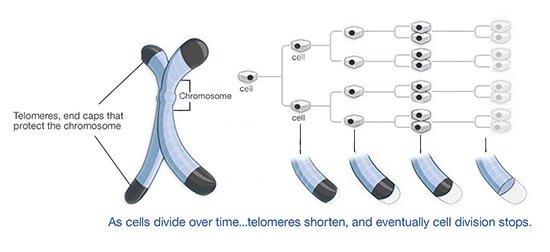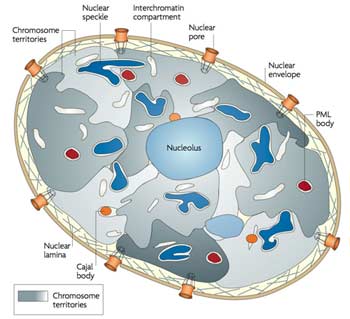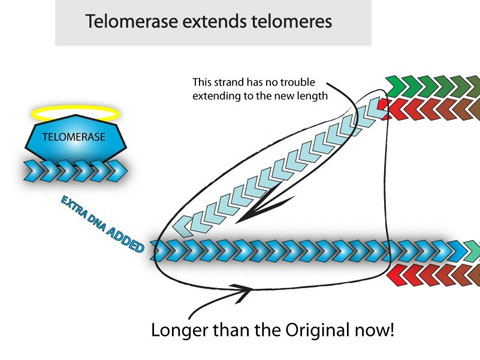Telomeres, Telomerase and Aging

In 1961 Leonard Hayflick discovered that nearly every cell in the body can only divide 30 to 90 times before cell division stops, called the “Hayflick limit”. Cells in the body are constantly lost due to injury, sickness and just unavoidable wear and tear and need to be replaced via cell division. Once this limit is hit cells of a specific type in a specific region of the body can be lacking, leading to muscles being weaker, organs not functioning as well, tissues being less flexible and generally the body being more aged. This is one of the main causes of aging.
Later other researchers found that the mechanism behind this limit was that every time a cell divides the system the cell uses to copy the DNA has a flaw such that a portion of the end of the DNA strand is left off of the new copy. In order to avoid this process deleting some vital instruction on the DNA, the ends of the DNA have a long chain of repeated, non-programming code of the genetic letters TTAGGG, called a telomere. This sacrificial end of the DNA repeats thousands of times, but a number of them are lost with each cell division. Once the telomere ends are below a certain critical length, the cell will refuse to divide further to avoid damaging the DNA. This creates a clock that ticks with each cell division down to the point where cell division stops.
cells have the ability to produce an enzyme called telomerase that is capable of adding telomeres back on to the end of the DNA
In the 1970's Elizabeth Blackburn discovered that cells have the ability to produce an enzyme called telomerase that is capable of adding telomeres back on to the end of the DNA, turning back the clock. This is how the cell resets itself between generations, so that a new body can undergo the great number of cell divisions required to build a new baby and to grow that baby into a new and youthful adult body. Even in an adult, the production of telomerase is turned on within a certain few cells in the body, such as those involved in reproduction and some other cells which are tasked to divide many more times than the average cell, such as adult stem cells. For this discovery Blackburn and a couple of her colleagues won the Nobel Prize in 2009.
In 2010 a group of researchers at Harvard and at two cancer research centers modified a group of mice be the age equivalent of an 80-year old human. These aged mice were then further modified to produce the enzyme telomerase. Over a 30-day period (human equivalent to 2.5 years) the mice dramatically reversed the aging process. Their organs, such as spleens, liver, testes, intestines, grew back to original size and function. Their muscles regained mass and strength. They became the physiological equivalent of youthful mice. Their brains grew back from 75% of youthful size to 100%. Their nervous system and mental function returned to a youthful state. They even became fertile again.
In 2012 a group of researchers at the Spanish National Cancer Research Institute, led by Maria Blasco, conducted this same test using a different manner to turn on the production of telomerase and using naturally aged mice. The result was the same sort of muscle, nerve and organ regeneration and a return to a more youthful state. Furthermore, the Blasco study found that the mice increased in median life span.
The Harvard and Blasco studies (and every other telomere extension study) have shown either lower, or the same, levels of cancer proliferation.
Telomere Extension in Humans
In 2005 human testing began of an ingredient called cycloastragenol that can activate telomerase production in humans. Cycloastragenol can be derived from the astragalus root, which is an edible plant part and thus cycloastragenol could be classified as a supplement which allowed this ingredient to be taken to the market much faster than if it were a synthetic drug ingredient. The first product to hit the market with this ingredient in 2007.
The astragalus root has been used in Chinese medicine for centuries. It is commonly used to make a tea that has many uses and has been used to make a lotion for more rapid wound healing. Perhaps this wound healing application had something to do with telomere extension. In any case, people have been consuming the root for generations without ill effect.
The results with cycloastragenol have been very positive, both in mice and in humans.

Blasco, the same researcher who led the Blasco study, tested cycloastragenol in mice and found that telomerase production was activated, telomeres were lengthened and lifespan increased with no increase in cancer. Senescent cells, worn out cells that do not divide due to having run out of telomeres, steadily reduced in number over the studies duration. Since senescent cells do not function properly, and bring down the function of neighboring cells and can even cause cancer, reducing senescent cells in this manner is worthwhile for reversing aging. Senescent cells transmit random molecular signals to the cells around them making neighboring cells confused and causing them to not perform well. This is another major cause of aging. Lengthening telomeres can prevent the formation of senescent cells in the first place. It also increases the number of immune cells by allowing more immune cells to be formed by cell division which can remove more senescent cells. Thus there are two mechanisms by which cycloastragenol can reduce senescent cell populations. Whichever is dominant, clearly this mouse data shows cycloastragenol had this positive effect.
A team from Whittier College and UCLA tested cycloastragenol in human cells in the lab and found that telomerase was activated (produced) and the number of cell divisions that a given set of cells could do was significantly increased, beyond the normal Hayflick limit. This is a very important test because it shows that cycloastragenol does what it is supposed to do. Cycloastragenol increased the number of cell divisions beyond the Hayflick limit, turning back the aging clock.
Proprietary human testing done by various companies and by multiple third party labs showed that although the average number of telomeres did not increase a large amount, the lengths of the shorter telomeres increased significantly when taking cycloastragenol. Later it was found by other researchers that in adult cells the cell limits the use of telomerase. If a cell is in a healthy state and if the cell has short telomeres, or if the cell undergoes cell division, the cell allows any telomerase present to lengthen the telomeres until they are at a moderate length, and then stops the telomerase from going further. This control mechanism may be the reason why earlier fears that telomere extension might promote cancer have turned out not to be valid. Also, the cancer researchers who did the Harvard and Blasco studies speculate that improvements in the immune system by telomere extension may be highly effective in keeping cancer in check as well as preventing cells going senescent and ultimately cancerous from there. Cancer occurs, after all, 10 times more in those over 65 as in those under 65.
increase in immune system function, improved vision, improved reproductive function, and more youthful skin
By extending the shorter telomeres the ability of a cell to divide is allowed to continue and cell populations can begin to return to more youthful populations…and senescence can be avoided.
Testing in humans also showed an increase in immune system function, improved vision, improved reproductive function, and more youthful skin. Anecdotal reports from many different sources have shown a pattern of improvement including better vision, better hearing, improved cardiovascular fitness, better sleep, more flexible skin, reduction in age spots, better concentration, more energy, fewer pains, better hair health and many other benefits. Typically a given individual experiences a few things from this list, but not all. And some people report no significant result. The variability of the results could be due to what portion of a particular person's aging process in a particular body part are due to hitting the telomere limit vs. other mechanisms of aging such as the build-up of oxidative free radicals or DNA damage. As a result not everyone who tries these telomere extending ingredients are happy with the results, but a large percentage of them do show a significant result. They recapture some abilities they had in their youth that they thought were long gone.
Many human diseases such as cancer, heart disease, multiple sclerosis, etc., have been shown to not only be associated with shorter telomeres but to be, in part, according to one study, caused by shorter telomeres. Given this and the improved organ function seen with telomere extension in mice, using a telomerase activator can make a big impact in both health and lifespan.
An Opportunity to Reduce Cost in the Telomere Extension

In early 2012 the “Telostep” project was launched around the realization that the molecules that activate telomerase production have an Achille's heal when it comes to these molecules making their way intact through the digestive system. A low cost method of protecting these highly expensive ingredients from the digestive system was developed and a proof of concept testing program was launched.
There is a certain gene that programs for the production of the telomerase enzyme. In early adulthood that gene is blocked by a covering molecule that attaches itself to the gene area like a cover. It is possible to remove that covering molecule with a different molecule that acts like a key in a lock to pop the covering molecule off of the DNA. In order to perform this function like a key in a lock, a telomerase activating molecule must have a certain shape and configuration. This means that the molecule must have certain chemical bonds and a certain structure. The closer these characteristics are to the ideal configuration the better the molecule will fit there and activate telomerase production. A molecule can get close to the ideal configuration and have weak telomerase activating ability. Cycloastragenol turns out to be very close to the ideal. So close that it appears to have 20 to 30 times better telomerase activation than Astragaloside IV, a molecule related to cycloastragenol that is also found in the astragalus root. Astragaloside IV appears to be the second best activator, behind cycloastragenol. This puts cycloastragenol in a class by itself, in terms of performance.
This need for a certain molecular shape and certain molecular bonds imply certain characteristics inherent to the molecule, such as the molecules inability to withstand acidic conditions.
One molecule that has been shown to have very weak telomerase activating ability is Omega 3. Omega 3 is much less active than the best ingredients used for telomerase production, but it does loosely fit into that lock and enable some telomere lengthening. Omega 3 has a very similar molecular configuration and chemical bonds as those more active ingredients. Omega 3 is significantly broken down by stomach acid. When Omega 3 is protected from stomach acid by a special coating, which dissolves in the intestines, 3 or more times the amount of Omega 3 can be measured in the bloodstream compared to taking the same amount of Omega 3 without the protection. This same sort of test has been applied to a number of molecules of a similar structure and the results are that 3 to 10 times more of the substance makes it into the bloodstream with protection than without.
The active ingredients that are most effective for telomerase activation are found in very small concentrations in the root of the astragalus plant. It takes hundreds of pounds of astragalus root to make enough of these ingredients for one person for one year. The concentration of the root is around 40,000 times to get pure cycloastragenol It is a very expensive extraction and purification process that results in a very high retail price.
And it is necessary to purify the cycloastragenol to a high standard. Astragalus root has a high iron content, just like broccoli does. If the iron in broccoli were concentrated 40,000 times a person could get iron poisoning from the result, just as one example of why purification to a high standard is important. The gold standard in cycloastragenol purification is 98% pure, which adds even more to the ingredient cost.
With protection from the digestive system, protection from breakdown by gastric acid, the amount a person should take could be cut to a third or less of what it otherwise would be. Currently there are thousands of people taking these ingredients even at this high price. But clearly such a high price is preventing the market from expanding beyond this wealthy few. Take the price down by a factor of 3 or more and many more people would be able to benefit from cycloastragenol.
clearly such a high price is preventing the market from expanding beyond this wealthy few
Telostep uses an acid resistant capsule shell to protect the cycloastragenol from acid exposure. This shell dissolves very quickly under the neutral to slightly basic conditions in the intestines, allowing for rapid release at the correct time for absorption.
Testing of Telostep began in the summer of 2012 with people taking one third the dose of non-stomach acid protected products. So far the people trying Telostep have reported the same benefits as traditional expensive cycloastragenol consumers report, such as improved vision, improved hearing, improved flexibility, improved concentration, better cardiovascular fitness, fewer pains, more youthful skin, better hair health, better sleep, etc.
What a particular individual experiences will vary depending on what parts of their body have cell populations that are telomere limited. Particular cell populations that are telomere limited may be so due to previous injury or illness that killed cells in a given region more than in other areas of the body due to old age. Thus some people will experience a benefit in a given area that others will not.
Cell division is critical to maintaining youthful function in every area of the body and is critical in wound healing. In both cases the body is replacing missing cells through cell division. And cell division can only take place with sufficient telomere length.
This product is not intended to diagnose, treat, cure or prevent any disease.
Read our full Legal Disclaimer and our Security/Privacy Policy
